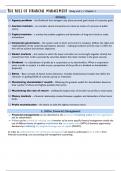Summary
Summary Financial management 202B Notes
- Course
- Institution
This document summarizes the financial management 2 syllabus (Corporate Finance) at IMM. These notes include information from lecture notes, study units, textbooks, and examples from past papers. This document contains theory and the practical sections of finance with examples. *Exam mark: 84...
[Show more]



